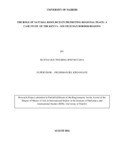| dc.description.abstract | Resources have been largely associated with resource based conflicts which are in various magnitudes. This could range from local, regional to international levels. Communities of nations have had to grapple with issues that translate to these conflicts. This study investigated this problem in the Kenya–South Sudan context in various spheres up to including border regions. The researcher was interested in establishing how resources found in Kenya and South Sudan can be harnessed to avert the never ending conflict between Turkana and Toposa of Kenya and South Sudan respectively. It also sought to find out how conflicts has been handled by respective governments and communities. It further explores various areas of cooperation between Kenya and South Sudan as well as challenges to regional peace. General objective of this study was to establish various aspects of this problem, particularly causes, effects and mitigation strategies. Among justifications of this study is that it will be useful to government of Kenya, South Sudan government and other stakeholders in undertaking effective intervention strategies to promote peace through natural resources. The Researcher reviewed literatures on concept of conflict, pastoralism, causes of conflicts, effects of conflict, and conflict management strategies, among others. The study used conflict theory, and the Democratic Peace theory to analyse the problem. The research is a case study, it used both quantitative and qualitative designs to collect and analyse data. Data collection method used was filling of questionnaires, personal interviews, key informants’ interview and documentation review. The researcher used proportionate simple random sampling method to arrive at the respondents groups stratified as, 42 non-governmental organisation operatives, 52 elites, 85 elders, 68 youth (both young men and women), 42 women and 36 religious representatives. Data analysis was conducted through the Statistical Package for Social Sciences, a renowned package for its efficiency and ability to handle large amounts of data given its wide spectrum for statistical procedures properly designed for social sciences. Overall findings and recommendations of the study is that respective governments of Kenya and South Sudan need to redouble their efforts to enhance cooperation and explore ways and means of sharing cross border resources in an effort to promote regional peace and resolve incessant conflict between Turkana and Toposa along the common border. The two governments need to strengthen Community based conflict prevention and management mechanism as well as open up the area through infrastructural development and resource sharing. | en_US |



